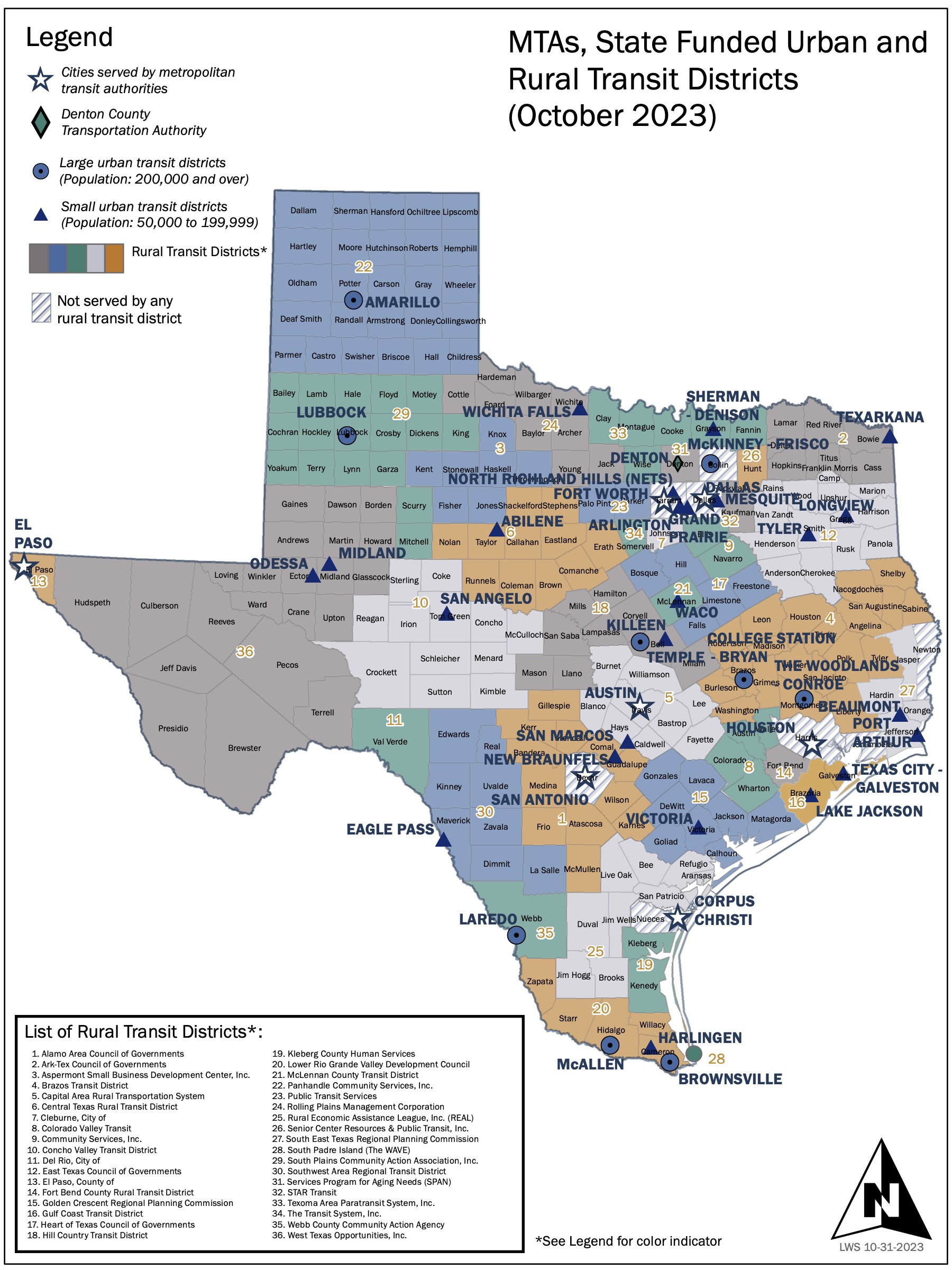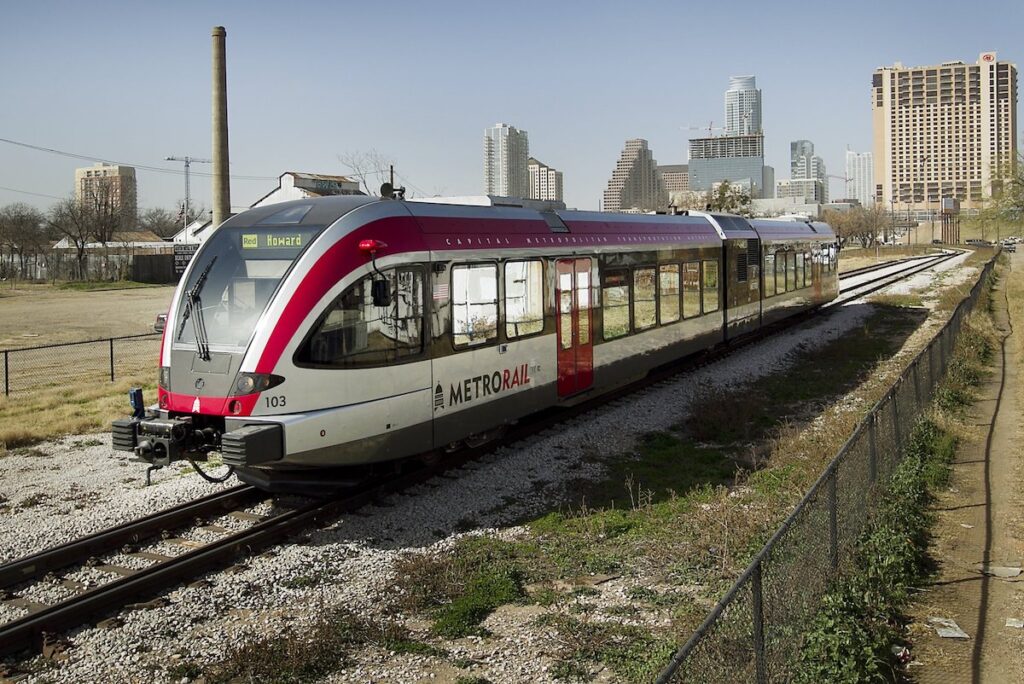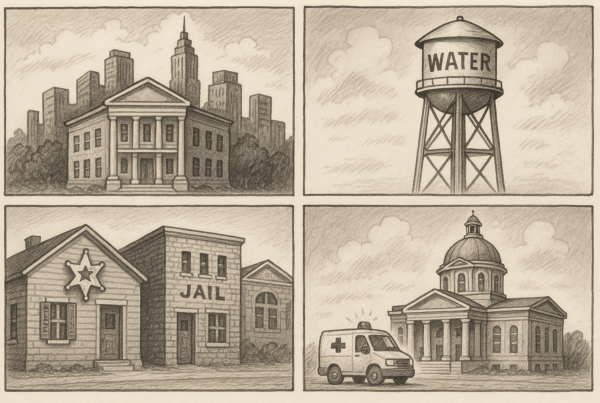Overview
The State of Texas has no statewide public transit system or statewide strategy but relies on three types of local government entities to provide services: rural transit districts, urban transit districts, and metropolitan transit authorities, or MTAs. Additionally, 58 Texas public entities offer limited service specifically for seniors and those with disabilities.
Fixed-route buses typically operate in larger towns or on key regional routes, offering scheduled service along designated paths. However, in more remote areas, demand-response services are often the primary option, providing flexible, on-call rides for individuals who cannot access scheduled bus routes. Vanpooling and carpooling programs are also common, especially for commuters who travel to neighboring towns or cities for work.
Train services are less common but are available in specific larger transit systems.

Rural Transit Districts
Texas’ 36 rural transit districts serve areas with fewer than 50,000 residents. These districts typically offer a combination of fixed-route bus services and demand-response transit (often referred to as dial-a-ride).
The largest rural transit districts by ridership are located in El Paso County, Fort Bend County, and South Padre Island. These areas have seen significant increases in population and demand for transit services in recent years, contributing to their large ridership numbers. These districts help bridge the gap between rural and urban transportation needs, ensuring that residents can access healthcare, education, and employment opportunities with greater ease.
Urban Transit Districts
An urban transit district in Texas typically operates within a “small urbanized area” with a population between 50,000 and 199,999. Texas is home to 21 such districts, which provide essential services to mid-sized urban areas. In addition, another 10 districts qualify for state funding under specific statutory exceptions, even though they serve areas with populations greater than 200,000.
One standout example is Bryan-College Station, which is operated by the Brazos Transit District. In fiscal year 2019, Bryan-College Station reported 6.7 million passenger trips and $10.8 million in operating expenses, making it the largest urban district by ridership.
Metropolitan Transit Authorities

The metropolitan transit authorities (MTAs) in Texas are responsible for providing transit services in areas with populations exceeding 200,000. These authorities are unique in their ability to levy local sales taxes to fund their operations, making them financially robust and capable of delivering a wide range of services.
Subtypes in this category include metropolitan rapid transit authorities (in Houston, San Antonio, Austin and Corpus Christi), regional transportation authorities (Dallas and Fort Worth), municipal transit departments (El Paso) and the Denton County Transportation Authority, a joint venture between Denton County and the cities of Denton and Lewisville.
Given the number of people they serve, MTA budgets are much larger than those of the smaller transit agencies. Harris County’s MTA, Houston Metro, delivered more than 90 million passenger trips with $575 million in operating costs in fiscal 2019, followed by Dallas Area Rapid Transit (DART) at nearly 63 million trips and $987 million in expenses.
This web of agencies and the relationships among them can be complex. Some rural transit districts are becoming urbanized, and some provide services in overlapping urban districts or in partnership with neighboring entities. In the Dallas-Fort Worth area, state law allows four urban districts to operate (and thus to receive state funding) within the DART service area.
Mass Transit Funding
Texas’ transit programs are funded by a mix of federal, state and local sources. Fares paid by riders make up only a small portion of their total funding. All Texas transit agencies are eligible for federal funds, including grants from the Federal Transit Administration (FTA) and Federal Highway Administration.
Transit Networks and Cooperation
The Texas public transit system is diverse and multi-layered, with complex interactions between different types of transit districts. Some rural transit districts are evolving into urbanized regions, and many districts collaborate or provide services within overlapping areas. A prime example of this is in the Dallas-Fort Worth area, where state law allows four urban districts to operate within the DART service area, ensuring efficient coverage and maximizing state funding.
In conclusion, Texas’ transit system is a complex network of rural, urban, and metropolitan entities, each with its own set of challenges and opportunities. While these districts provide essential services, they also face issues related to funding, coverage gaps, and the increasing demands of a growing population.


